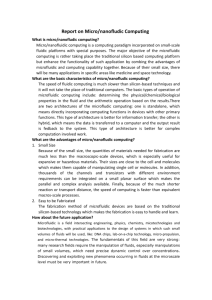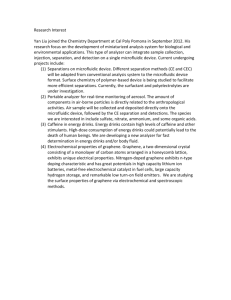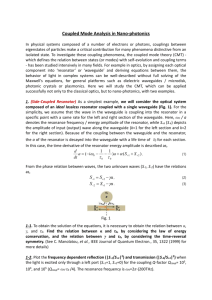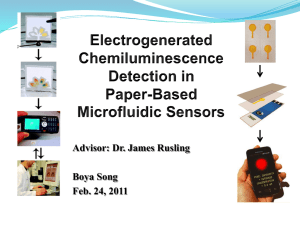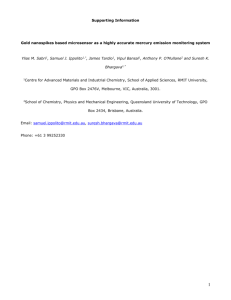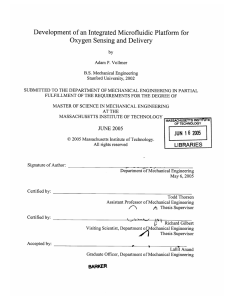Microfluidic and Transducer Technologies for Lab
advertisement
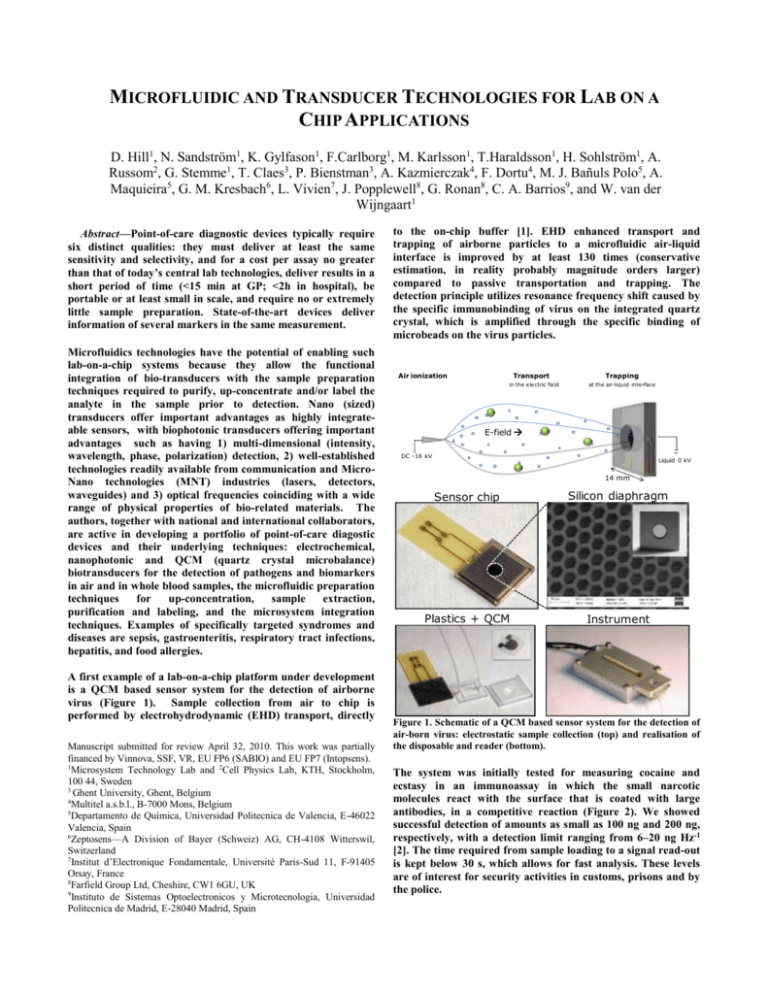
MICROFLUIDIC AND TRANSDUCER TECHNOLOGIES FOR LAB ON A CHIP APPLICATIONS D. Hill1, N. Sandström1, K. Gylfason1, F.Carlborg1, M. Karlsson1, T.Haraldsson1, H. Sohlström1, A. Russom2, G. Stemme1, T. Claes3, P. Bienstman3, A. Kazmierczak4, F. Dortu4, M. J. Bañuls Polo5, A. Maquieira5, G. M. Kresbach6, L. Vivien7, J. Popplewell8, G. Ronan8, C. A. Barrios9, and W. van der Wijngaart1 Abstract—Point-of-care diagnostic devices typically require six distinct qualities: they must deliver at least the same sensitivity and selectivity, and for a cost per assay no greater than that of today’s central lab technologies, deliver results in a short period of time (<15 min at GP; <2h in hospital), be portable or at least small in scale, and require no or extremely little sample preparation. State-of-the-art devices deliver information of several markers in the same measurement. Microfluidics technologies have the potential of enabling such lab-on-a-chip systems because they allow the functional integration of bio-transducers with the sample preparation techniques required to purify, up-concentrate and/or label the analyte in the sample prior to detection. Nano (sized) transducers offer important advantages as highly integrateable sensors, with biophotonic transducers offering important advantages such as having 1) multi-dimensional (intensity, wavelength, phase, polarization) detection, 2) well-established technologies readily available from communication and MicroNano technologies (MNT) industries (lasers, detectors, waveguides) and 3) optical frequencies coinciding with a wide range of physical properties of bio-related materials. The authors, together with national and international collaborators, are active in developing a portfolio of point-of-care diagostic devices and their underlying techniques: electrochemical, nanophotonic and QCM (quartz crystal microbalance) biotransducers for the detection of pathogens and biomarkers in air and in whole blood samples, the microfluidic preparation techniques for up-concentration, sample extraction, purification and labeling, and the microsystem integration techniques. Examples of specifically targeted syndromes and diseases are sepsis, gastroenteritis, respiratory tract infections, hepatitis, and food allergies. A first example of a lab-on-a-chip platform under development is a QCM based sensor system for the detection of airborne virus (Figure 1). Sample collection from air to chip is performed by electrohydrodynamic (EHD) transport, directly Manuscript submitted for review April 32, 2010. This work was partially financed by Vinnova, SSF, VR, EU FP6 (SABIO) and EU FP7 (Intopsens). 1 Microsystem Technology Lab and 2Cell Physics Lab, KTH, Stockholm, 100 44, Sweden 3 Ghent University, Ghent, Belgium 4 Multitel a.s.b.l., B-7000 Mons, Belgium 5 Departamento de Química, Universidad Politecnica de Valencia, E-46022 Valencia, Spain 6 Zeptosens—A Division of Bayer (Schweiz) AG, CH-4108 Witterswil, Switzerland 7 Institut d’Electronique Fondamentale, Université Paris-Sud 11, F-91405 Orsay, France 8 Farfield Group Ltd, Cheshire, CW1 6GU, UK 9 Instituto de Sistemas Optoelectronicos y Microtecnologia, Universidad Politecnica de Madrid, E-28040 Madrid, Spain to the on-chip buffer [1]. EHD enhanced transport and trapping of airborne particles to a microfluidic air-liquid interface is improved by at least 130 times (conservative estimation, in reality probably magnitude orders larger) compared to passive transportation and trapping. The detection principle utilizes resonance frequency shift caused by the specific immunobinding of virus on the integrated quartz crystal, which is amplified through the specific binding of microbeads on the virus particles. Air ionization Transport in the electric field Trapping at the air-liquid interface E-field DC –16 kV Liquid 0 kV 14 mm Sensor chip Silicon diaphragm Plastics + QCM Instrument Figure 1. Schematic of a QCM based sensor system for the detection of air-born virus: electrostatic sample collection (top) and realisation of the disposable and reader (bottom). The system was initially tested for measuring cocaine and ecstasy in an immunoassay in which the small narcotic molecules react with the surface that is coated with large antibodies, in a competitive reaction (Figure 2). We showed successful detection of amounts as small as 100 ng and 200 ng, respectively, with a detection limit ranging from 6–20 ng Hz-1 [2]. The time required from sample loading to a signal read-out is kept below 30 s, which allows for fast analysis. These levels are of interest for security activities in customs, prisons and by the police. Figure 2: (a) Measured QCM-based microsensor response to the subsequent loading of the system with (1) antibodies, (2) antibody binding, (3) 200 ng ecstasy loaded sample, (4) 300 ng ecstasy loaded sample and (5) a blank sample run. In order to verify that the system was not depleted from antibodies another run was made with 200 ng ecstasy loaded sample. Starting frequency 10 009 960 Hz. (b) Measured system response to the subsequent loading of the system with (1) antibodies targeted for cocaine, (2) antibody binding, (3) first blank run, (4) and (5) 100 ng cocaine loaded samples, (6) second blank sample run. Starting frequency 10 008 100 Hz. Within the EU FP7 project InTopSens: (www.intopsens.eu), similar nano-photonic sensors are used as bio-transducers in the development of a point-of-care solution for the detection of sepsis and the antibiotic resistance profiling of the bacteria. Silicon on insulator (SOI) ring resonators, with 70 nm/RIU sensitivity for bulk changes in the refractive index, and a limit of detection of 10–5 RIU, which for biotin-avidin sensing corresponded to 10 ng/ml had previously been demonstrated [5]. For bulk changes in the refractive index a greater sensitivity of 298 nm/RIU was recorded for slot-waveguide racetrack resonators in the high-index-contrast SOI material system [6]. From a calculated resonance wavelength resolution of 12.5 pm, however, the detection limit is 4.2×10-5 RIU, worse than that of the above described SABIO biosensor, due to bending and mismatch losses resulting in a low quality factor of this resonator (330). We have demonstrated therefore for the first time that surface chemistry for selective label-free sensing of proteins can be applied inside a 100 nm-wide slot region and that the application of a slot waveguide instead of a normal waveguide increases the sensitivity of an SOI ring resonator with a factor 3.5 for the detection of proteins. With a limit of detection improvement possible for ring resonator recognition of biotin/avidin down to 1 ng/ml the focus within sensor development has now shifted to the realisation of other innovative designs based on the ring resonators and MZI with folded waveguides [7] which are robust against temperature and optical losses, and compatible with advanced waveguide technology (slot waveguides, slow light, etc). Within the EU FP6 project SABIO (www.ee.kth.se/sabio), a second lab on a chip platform was developed that consists of an integrated nanophotonic slot-waveguide biosensor with simultaneous six-plex readout [3] for six biomarker label-free hepatitis diagnosis (Figure 3). Recent publications [3, 4] demonstrated its detection limits to be as low as 5 × 10−6 RIU with a sensitivity as high as 240 nm/RIU over a 7 K temperature operating window, without need of external temperature control or individual sensor calibration. Bulk concentrations down to 100 ng/ml of anti-BSA were measured, with a surface mass density detection limit for a glutaraldehyde-antiBSA model assay of 0.9 pg/mm2. Figure 4. Demonstrator of a densily integrated 3D microfluidic network: a 3D basket weave channel structure in PDMS with channels crossing under and over each other, with 105 vertical fluidic interconnects in an area of ~1cm2. The channel width in both layers is 100 μm, the circular vertical interconnects is 120 μm in diameter and the vias layer thickness is 60 μm. In parallel to these activities DNA detection using a photonic crystal waveguide based optical sensor has demonstrated a detection limit of 22.2 nM for hybridized biotinylated DNA oligomers on the streptavidin-coated silicon biosensor. Preliminary results from recent DNA hybridization experiments [8] show the feasibility of detecting DNA strand concentrations below 100nM. Figure 3. A top view of the layout of the SABIO optical chip: Light is injected at the surface grating coupler (C) and split, by the multi-mode interference splitter (B), to the six sensing channels M1–M6 and the two reference channels REF1 and REF2. Inset are an optical micro-graph of the splitter (B); and electron micrographs of the grating coupler (C), and aslot-waveguide ring resonator (A), with an enlargement of the coupling region. The overall approach in InTopSens is to separate and upconcentrate the bacteria from whole blood using inertial microfluidic techniques [9] in combination with selective blood lysis, keeping bacteria intact [10]. After bacterial lysis and integrated multiplex PCR, the PCR product hybridises on an 8x8 photonic biosensor array. To enable the fabrication of densily integrated 3D microfluidic structures, we developed novel PDMS microfabrication techniques that allow the robust fabrication of densely spaced vertical vias [11] (Figure 4). This technique allows the integration of the microfluidic control valves, PCR, and the sensor array in a single and compact cartridge (Figure 5). valving, vacuum, waste Sample in Light in Covalently bonded layer stack Camera readout Peltier temp. ctrl Figure 5. Schematic of an integrated PCR – photonic transducer cartridge for diagnostics of sepsis. In a final example we look ahead to the development of porous silicon based bio-photonic sensors (Figure 6) for point of care food allergy determination within another FP7 ICT project, Positive, which begins 1st September 2010. The very high surface to volume ratio of porous silicon permits very high surface densities of bound antibody-antigen complexes in a reduced volume that through a novel optical interaction leads to scores of sensing areas on a 1 cm2 chip with detection-limits down to 0.1 pg/mm2, significantly beyond state of the art for highly integrated label free sensors at point of care. The microfluidics packaging includes integrated sample preparation from a drop of blood. Figure 6. Scheme of the steps leading up to and including the final prevalidation from the Positive biochip preparation onwards. REFERENCES [1] [2] [3] Sandström et al.,”Electrohydrodynamic enchanced transport and trapping of airborne particles to a microfluidic air-liquid interface” Proc. IEEE MEMS 2008. Frisk et al., ”An integrated QCM-based narcotics sensing microsystem”, Lab-Chip, 2008, 8, 1648. Carlborg et al.,”A packaged optical slot-waveguide ring resonator sensor array for multiplex label-free assays in labs-on-chips” Lab Chip, 2010, 10, 281. K. Gylfason et al., ” On-chip temperature compensation in an integrated slot-waveguide ring resonator refractive index sensor array ” Optics Express, 2010, 18, 4, 3226 [5] K. De Vos et al., ” On-chip temperature compensation in an integrated slot-waveguide ring resonator refractive index sensor array” Optics Express, no. 12 (2007), 15, 7610-7615 [6] T. Claes et al., ”Label-free biosensing with a slot waveguide based ring resonator in silicon-on-insulator”, J. IEEE Photonics, no. 3 (2009), 1, 197-204 [7] A. Densmore et al., “Spiral-path high-sensitivity silicon photonic wire molecular sensor with temperature-independent response”, Opt. Lett. 2008, 33 no. 6, 596–598 [8] V. Toccafondo et al., “DNA detection using a photonic crystal waveguide sensor”, submitted to OSA Optics and Photonics Conference [9] A. Russom et al., “Differential inertial focusing of particles in curved low-aspect-ratio microchannels”New Journal of Physics 11 (2009) 075025 [10] J. Lindqvist et al., “Microfluidic system for selective cell lysis”, Proc. European lab-on-a-chip congress 2009 [11] F. Carlborg et al.,” Large scale integrated 3D microfluidic networks through high yield fabrication of vertical vias in PDMS”, Proc. IEEE MEMS 2010. [4]
